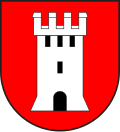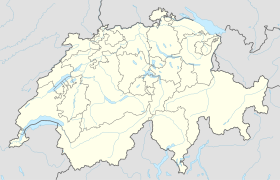Toboggan
| Toboggan | ||
|---|---|---|
| State : |
|
|
| Canton : |
|
|
| Region : | Viamala | |
| Circle : | Domleschg - Until December 31, 2017 | |
| Political community : | Domleschg | |
| Postal code : | 7415 | |
| former BFS no. : | 3636 | |
| Coordinates : | 752 938 / 178484 | |
| Height : | 684 m above sea level M. | |
| Area : | 1.68 km² | |
| Residents: | 269 (December 31, 2014) | |
| Population density : | 160 inhabitants per km² | |
| Website: | www.domleschg.ch | |
|
Toboggan |
||
| map | ||
|
|
||
Rodels ( Rhaeto-Romanic Roten ) is a village in the political municipality Domleschg , which lies in the district of Domleschg in the Viamala region in the Swiss canton of Graubünden .
coat of arms
Blazon : In red a silver (white) tin tower
Based on the coat of arms of the Turian family (Torriani / Toreani) attached to the Giger house .
geography
The street village lies on a terrace east of the Hinterrhein on the western slope of the Stätzerhorn chain . The Nueins fraction also belongs to the former municipality . Exactly half of the entire former municipality area of 168 hectares can be used for agriculture. Another 59 hectares are covered by forest and wood. There are also 18 ha of settlement area and 7 ha of unproductive area.
history
Until December 31, 2014, Rodels was a separate political municipality . On January 1, 2015, it merged with the municipalities of Almens , Paspels , Pratval and Tomils to form the new municipality of Domleschg .
population
| Population development | ||||||||||
|---|---|---|---|---|---|---|---|---|---|---|
| year | 1803 | 1850 | 1900 | 1950 | 1970 | 1980 | 1990 | 2000 | 2005 | 2014 |
| Residents | 106 | 135 | 147 | 178 | 152 | 155 | 222 | 281 | 271 | 269 |
languages
The original language of the population was Sutselvisch , a Romansh dialect. But already in the late 19th century there was a change in language towards German. While in 1880 62% of the population still spoke Romansh, in 1900 it was only 52%. As early as 1910, the former community with 59.12% German speakers and 40% Romansh speakers had tipped over. The process of shrinking Romansh continued at a slower pace until 1980. In the 1980s, a final decline began, which meant that Romansh is now of little importance.
This is also shown in the following table:
| Languages in toboggans | ||||||
| languages | 1980 census | 1990 census | 2000 census | |||
| number | proportion of | number | proportion of | number | proportion of | |
| German | 125 | 80.65% | 204 | 91.89% | 255 | 90.75% |
| Romansh | 25th | 16.13% | 10 | 4.50% | 11 | 3.91% |
| Italian | 5 | 3.23% | 5 | 2.25% | 5 | 1.78% |
| Residents | 155 | 100% | 222 | 100% | 281 | 100% |
7.9% of the population still understand Romansh, but German is the only official language today.
Origin and nationality
Of the 271 residents at the end of 2005, 260 (= 96%) were Swiss citizens.
Attractions
- Catholic parish church St. Christophorus and Jakobus the Elder Ä.
- House of Blumenthal
literature
- Erwin Poeschel : The art monuments of the canton of Graubünden III. The valley communities Räzünser Boden, Domleschg, Heinzenberg, Oberhalbstein, Upper and Lower Engadine. (= Art Monuments of Switzerland. Volume 11). Edited by the Society for Swiss Art History GSK. Bern 1940. DNB 760079625 .
- 200 years of the canton of Graubünden. The municipalities of the canton of Graubünden. Chur / Zurich 2003, ISBN 3-7253-0741-5
- The Domleschg / La Tumleastga. Chur 2005, ISBN 3-905342-26-X
- Mathias Kundert: The language change in Domleschg and on Heinzenberg (19th / 20th century). Commission publisher Desertina, Chur 2007, ISBN 978-3-85637-340-5 .
- Jürg Simonett: tobogganing. In: Historical Lexicon of Switzerland . 2016 .
Web links
- Tobogganing on the ETHorama platform
- Official website of the municipality of Rodels



